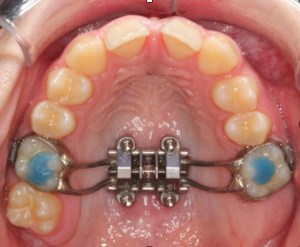Published: April, 23 2025
How do Stainless Steel TADS and asynchronous digital planning make all of this better?
It seems that a consensus across many groups is being formed regarding the vernacular and acronyms use to describe these appliances. The (MSE) mini-screw supported expander made available by Korean Manufacturer Korea Bio Materials and distributed by Great Lakes Orthodontic Laboratory was made available to US clinicians in 2018. Dr. Won Moon is credited for testing it and making it popular with both case presentations, articles and lectures. The orthodontic community was thrilled to have a new tool for maxillary expansion with support that is bone borne, but we struggled to have consistency in outcomes across the adult population. The limits of the non customized approach became apparent especially in adult men where 4 TADS just wasn’t enough to achieve skeletal expansion. Treatment complications of tissue impingement, lack of suture separation were frequent when using this device for adult men. It is a reasonable solution for non growing teens with careful selection of tad lengths by CBCT after cementation but it limits the clinician to using titanium tads compatible with the device and only available from Great Lakes Orthodontic lab.


The fusion of STL file data of 3D models with CBCT data of the maxillary anatomy to customize laser sintered custom MARPE appliances is one of the most exciting innovations in the specialty of orthodontics today (1). Innovative orthodontic labs of Partners dental studio, of Minnesota, Specialty Dental Lab in Atlanta, and Cottonwood lab in Salt Lake City have begun to use the distinction of MARPE or customized MARPE as the acronym to describe a appliance created from digital data merged from stl models and cbct dicom for customized digital planning of TAD length, diameter, and insertion site with bicortical anchorage being the primary goal. Customizing for age and gender of the patient with the number and location of TADS is now a game changer resulting in limiting the treatment failures and complications associated with non customized MSE appliances.



A fervor of collaboration is occurring in the orthodontic specialty in online forums, individual study clubs and lecture venues. Leading clinicians like Audrey Yoon, Ilya Lipkin and Marianna Evans are leading these discussions with wonderful courage and unwavering commitment. When studying all of the sharing with an objective lens, it seems that the acronym of MARPE is gradually becoming a misnomer. “Rapid” palatal expansion of 4 turns a delivery and 2 turns/day is now being viewed as unnecessary and even contributing to the complications bone borne expanders. SLOW is now the new protocol. One turn/day of the Tiger Screw component representing only .17 mm is the common protocol for successful expansion . I prefer to have the patients turn 20 times and then customize further expansion relative to the needs of the case . Celebrate with the patient whenever the diastema appears which usually occurs between 20-30 turns. There is even the exciting idea of only one turn /week with simultaneous maxillary midline diastema control while wearing aligners with that precise amount of maxillary midline space closure included! This would be the Yoon/Roblee “No Diastema Protocol”. Beyond this, some are reporting success with forward and backward “Polycyclic” turning of 7 forward and 7 backward when a split seems to be difficult to achieve or as an alternative to piezo-incision for adult men.
Preventing complications has caused some clinicians (Richard Ting and Ilya Lipkin ) to recommend mid palatal piezo-incision for adult males over the age of 25. This procedure is very simple. No more complicated that doing a class 1 amalgam preparation in a first molar, a simple 3 mm depth bony incision can be executed from the distal aspect of the first molar the mesial aspect of the first premolar along the midpalatal suture .
John Sherry of Austin Texas is an oral surgeon who is suggesting the need for Zygomatic buttress cuts for adult men but most clinicians across the country are reporting successful expansion without it. In stead, many are reporting success selective midpalatal piezo-incision for adult men over 25. Pteryomaxillary suture release as made popular in the days of Surgically-assisted palatal expansion (SARPE) is now being viewed as unnecessary by most which is a wonderful advancement considering that this would sometime compromise blood supply to the buccal segments of teeth. Without thes lateral cuts, the “APEX” effect is being enjoyed. This “APEX effect “as coined by Sherry and his partner Gannon is a neat way to describe how the right and left halves of the maxilla tip laterally in space during expansion to increase the volume of the nasal cavity with the base of change at the floor of the nose and the “APEX” of change at the naso-frontal bone interface. This maximizes the change of airflow through the nasal cavity compared to a Lefort procedure multi piece maxilla or SARPE where the incisions apical to the dentition limit expansion to the body of the maxilla rather than allowing expansion all the way up to the “APEX” of the nasal cavity. For this reason many are intentionally including MASPE into presurgical case plannng to prevent multiple piece maxilla procedures at the time of two jaw surgery of large class three discrepancy cases. This is usually received with gratitude from our oral surgery colleagues who deal with much less struggle when they can advance the maxilla in one piece and the patient enjoys the nasal airflow increase of the APEX effect. Everyone wins!



It is intriguing to consider how using stainless steel tads rather than traditional titanium tads in combination with 3D custom MARPE( MASPE) appliances can further enhance and simplify the insertion process of these orthodontic devices. Experienced clinicians are reporting the following advantages (3).